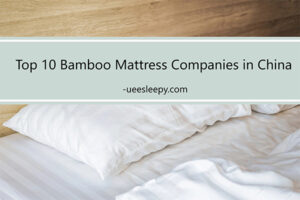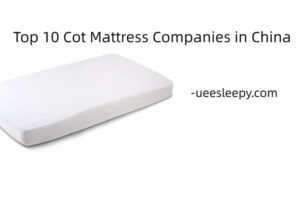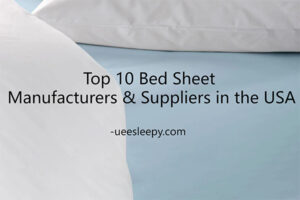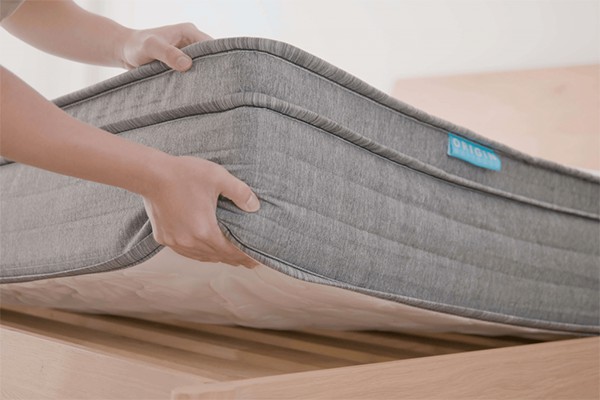With so many brands claiming to have the “best” mattress, it can be challenging to know where to start looking for a new bed. That’s why we made this guide, which breaks down every part of the mattress buying process to help you find the right mattress for you. In our mattress buying guide, we’ll go over everything you should consider when you’re ready to choose a new mattress.
1. When do you need a new mattress?
A general rule is that you should replace your mattress every 7-10 years. After sleeping on it every night with frequent use, the mattress will deform and no longer provide a surface for restorative sleep.
2. What not to do when buying a mattress
Here are a few tips to keep in mind when shopping around for a new bed before we get into the details.
- Do not buy a bed that is too soft
- Price does not equal quality
- Do not buy a bed just for cooling
- Do not make a judgment before 21 days
- Do not buy at full price
3. What is the average lifespan of a mattress?
Most mattresses last between 7-10 years, but this varies by type. Innersprings have the shortest lifespan at 7-8 years, foam mattresses are in the middle at up to 10 years, and latex mattresses have the longest lifespan at 15 years.
4. How do you know you need to buy a new mattress?
There are some warning signs you can look out for to know it’s time for a new mattress. These include waking up with pain or numbness in your extremities, being often groggy or aching, tossing and turning throughout the night, your mattress feeling a little saggy or lumpy, you feeling like you’ve sunk in too deep, you’re in a hotel room or something other than your own bed sleep better, or you can feel your sleep partner making the slightest movement on the other side of the bed.

5. What is the best mattress for me?
The best mattress varies from person to person based on their individual sleeping patterns and preferences. Different sleepers need different mattresses, so what’s right for you may not always be the best mattress for someone else. Comfort is subjective, but knowing mattress firmness and the different mattress types will help you narrow things down when testing mattresses in your store.
How firm should the mattress be? It all depends on how you prefer to sleep.
If you sleep on your stomach… you’ll keep your spine aligned with a firm mattress.
If you sleep on your back… a medium mattress supports your spine, back, and neck while keeping you comfortable.
If you sleep on your side… the soft mattress will support and shape the curves of your body.
6. Types of mattresses
After deciding it’s time for a new, upgraded mattress, the next step is to determine which type is best for you. Sleeping position, budget, and body type are all factors to consider.
There’s plenty of research on different mattress materials and their uses, but we’ve simplified what you really need to know about the most popular mattress types, including memory foam, innerspring, latex, and hybrid mattresses.
1) Foam/memory foam mattress
Advantage
- Affordable
- Good at keeping motion shifting to a minimum (you won’t feel your sleeping partner moving)
- Helps relieve back pain
- Helps relieve pressure point pain
- Contours and conforms to your body
Shortcoming
- Doesn’t offer as much freedom of movement
- Some models trap body heat to make you sleep hot
- Mattresses with inner springs tend to be thinner
- If foams are not marked as CertiPUR-US certified, they can be harmful to the environment and air quality in your bedroom
- Not always suitable for people who sleep on their stomachs as this can cause misalignment which can lead to back pain
Foam and memory foam mattresses make up the bulk of mattresses online, which is no surprise since memory foam mattresses are known to be one of the more comfortable mattress types.
These are usually mid-level on the firmness scale and tend to be better suited for people with back pain, as the memory foam layer helps with lumbar support, hip and shoulder comfort, and body contouring. It’s also great for motion transfer (if your partner moves a lot, you won’t feel it).
A memory foam mattress will be more contoured, meaning it will conform to your body better than other mattresses and won’t offer as much bounce or freedom of movement. So if you don’t usually move around throughout the night, memory foam might be a good option for you. It’s also worth noting that many of the “foam” mattresses you see today aren’t pure memory foam, but foams that have been mixed with other materials.
This mattress type is known for sleeping hot thanks to the hug that memory foam provides. However, Helen Sullivan, a spokesperson for CertiPUR-US, says new foam technology has largely alleviated the problem:
“When these foams first became popular, some people claimed they were warmer to sleep on. However, advances in foam production technology through the use of different foam formulations, and in some cases, special cooling foams, cooling gel foams, etc. largely eliminate these problems.”
2) Innerspring Mattress
Advantage
- Responsive (good if you’re changing positions throughout the night)
- Strong Edge Support
- Good airflow (helps keep you cool)
Shortcoming
- Can be expensive
- Heavy/difficult to maneuver
- Won’t contour your body or provide as much comfortable support over pain points
When you think of traditional mattresses, innerspring, or coils, it probably comes to mind. This is one of the most widely used types of mattresses and is made of at least one layer of spring metal coils. The bounce of innerspring mattresses is excellent, they have good edge support, and they keep you cool.
Due to the metal coils inside, these types of beds are heavy and can be shipped full size (if that affects your decision). An innerspring mattress might not be right for you if you’re looking for something that contours your body nicely.
Since there’s quite a bit of room in these mattresses, your shoulders and hips won’t get as much support as you would with other types of mattresses, but you’ll have more freedom of movement if you tend to move around a lot at night.
Number of coils
The number of coils in an innerspring or hybrid bed is not as important as it seems. However, generally, the more coils in a mattress, the higher the quality. That’s not to say your mattress isn’t high quality if it doesn’t have many coils, but you might want to stay away from any mattress with fewer than 420 Bonnell coils, as the quality and support will be lacking.
The coil gauge is another thing to consider when it comes to coils. A coil gauge is simply a measure of the thickness of the wire used in the coil. Coil gauges can range from 12 to 15, the lower the coil gauge, the firmer the mattress. If you want a softer mattress and are looking for a bed with coils, make sure the coil gauge is right around the 14 to 15 mark. These coils have a softer spring, which makes the mattress feel softer.

3) Latex mattress
Advantage
- Provides stress relief + freedom of movement
- Durable to last a long time (up to 15 years)
- Sleep well
Shortcoming
- Expensive
- Very heavy/difficult to maneuver
- If not organic, may contain harmful chemicals
Latex mattresses are great for those who want the many benefits of a foam mattress but without the hugging or “bending.” These mattresses tend to have great cooling properties, bounce and still be responsive — meaning it adapts to your body as you move around.
“Latex is great because it has the bounce of a box spring mattress but locks you in like memory foam,” says Saatva CEO Ron Rudzin. Longest lifespan of any pad type.
What are the disadvantages? Latex mattresses tend to be more expensive. They’re also very dense, which means they’ll be on the heavier side. Depending on the type of latex you get, you may notice some synthetic chemical smell during the first few days.
4) Hybrid Mattress
A hybrid mattress typically refers to a mattress made from a combination of memory foam and springs, but it can also include other materials and combinations (such as latex and memory foam). Compared to pure memory foam, the hybrid foam provides a good balance of support and pressure relief. With the help of more motion-absorbing layers, the hybrid’s motion transfer will also be better than with the inner springs alone.
If you and your significant other want different mattresses, a hybrid mattress might be right for you. It can, however, sometimes be more expensive to get the best of both worlds. In some cases, hybrid mattresses can also be quite heavy, making shipping and handling difficult.
Helix Sleep co-founder Adam Tishman specializes in custom hybrid mattresses. He said:
“Hybrid mattresses combine the best features of both types of mattresses. You get the bounce and support of the springs balanced with the contouring and cushioning of the foam. Traditional full innerspring beds feel stiff and don’t isolate motion very well, while all memory foam beds were very hot and felt too dense. It’s all about the right balance!”
7. What to look for in a mattress
If you’ve done any research on mattresses, you’ve probably noticed that the mattress industry has its own jargon, like “responsiveness” and “motion transfer.” While they may seem like meaningless marketing terms, they are actually important factors to consider when choosing the mattress that best meets your needs. We’ll walk you through these important mattress features in plain language to help you understand why they’re so important when you’re looking for the best mattress.
Choosing a new mattress involves many factors, so it’s important to note that you don’t know how well a mattress performs until you try it for a few nights. So if you’re not sure which mattress is best for you, be sure to buy one that comes with a risk-free trial period. Other important factors include spinal alignment, pressure relief, shipping and return policies, and firmness.
1) Comfort
Comfort is important because it determines how your mattress feels and how it adapts to your movements and regulates temperature. Mattresses that are too firm, too warm, or have too much movement on the other side of the bed (if you sleep with a partner) can cause discomfort. This can lead to more disrupted sleep, so it’s imperative that you find a comfortable mattress that will allow you to get a good night’s sleep. When it comes to comfort, responsiveness, temperature control, and motion transfer are some of the key factors to consider.
#1. Responsiveness
Quick definition: How well the mattress responds to your movements and adjusts to your body position.
Responsiveness simply means how well the mattress responds and adjusts to body movements while you sleep. We all move while we sleep, but reflexes are especially important for restless and combination sleepers who change positions during the night.
#2. Motion transfer
Quick Definition: The ability of a mattress to isolate and absorb motion.
Motion transfer refers to the ability of a mattress to absorb motion. Many people overlook this factor, but it’s an important quality to look for—especially for couples who share a bed and those with children or pets who crawl in and out of bed throughout the night. Memory foam and foam hybrid mattresses tend to be the best choice for motion transfer.
#3. Thermoregulation (or Cooling)
Quick Definition: A mattress’ ability to promote airflow and breathability, taking into account heat retention and any substantial cooling properties.
When you sleep, you want to make sure your mattress helps move heat away from your body, rather than trapping it within its layers so that you wake up sweaty or clammy. Mattresses with breathable or air-filled layers help increase airflow, which provides a cool sleeping surface. Absorbent materials such as fleece cover radiate heat and carry it away from your body.
2) Support
The support of your mattress is critical to ensuring a healthy back, healthy joints, and long-lasting beds. Spine alignment, pressure relief, edge support, and durability are some of the most important support factors to consider.

#1. Spine alignment
Quick definition: How well the mattress keeps your spine in natural alignment.
When you’re comparing mattresses, you want to look for something that will support your body and keep your spine in a natural position. A healthy spinal position allows your muscles to rest, which means you’ll wake up feeling more refreshed in the morning.
The line from your tailbone to your neck should be straight if you sleep on your side. If you like to sleep on your back, your spine should maintain its natural curvature when lying on a mattress that provides good support. By the nature of the posture alone, prone people have more trouble maintaining their natural curves. As a rule of thumb, a good mattress should conform to the shape of your spine while supporting your weight and keeping your back properly aligned, says Vik Singh, founder of Spine & Vigor.
#2. Pressure relief
Quick Definition: The effect of the mattress on relieving pressure (especially in the hips, shoulders, and thighs) and providing even weight distribution.
The best mattress is one that distributes your weight evenly so that your hips and shoulders don’t sink too far. If they do, your mattress may be putting pressure on your pressure points.
You need to look for a mattress that pushes back when you apply pressure (but not too much). Different mattresses will provide better pressure relief for different body types – so if you’re lighter you won’t need as much pushback, but if you’re heavier you’ll want to make sure the mattress is With the right support, you won’t get bogged down too much.
#3. Edge support
A quick definition: how much edge support the mattress provides, taking into account the functional use of the mattress ends and the comfort of sleeping on the side of the bed.
Edge support keeps you from rolling off your mattress in the middle of the night. Innerspring mattresses usually have a separate support layer around the edge to help you stay on top, while foam mattresses usually don’t have a separate edge layer. However, it is also more difficult to “roll-off” a foam mattress.
This factor is important if you’re a particularly restless sleeper (or have a history of falling out of bed…), or if you use the end of your bed to wear your socks and shoes in the morning.
#4. Durability
Quick Definition: The materials and designs of a mattress determine its lifespan and ability to provide a comfortable night’s sleep.
Mattresses should be made from high-quality, durable materials (preferably without a lot of harmful chemicals). The strength of the material is important – you don’t want sag or lumps, and you want your mattress to remain bouncy and supportive for years to come.
3) Hardness
Quick Definition: How firm or contoured your mattress feels.
The firmness of a mattress determines its comfort and support. Keep your own preferences and needs in mind when deciding on the firmness level that’s right for you. While everyone is different, your sleep type generally helps determine the level of mattress firmness you should be looking for for your ideal level of comfort.
Hardness is measured on a scale of 1-10, with 10 being the hardest. (But honestly, unless you’re comfortable sleeping on a pile of cotton balls or a wooden floor, we don’t recommend extreme values of 1 or 10).
- Side sleepers tend to prefer softer mattresses (3-6) that contour their body well and provide comfortable support around the hips and shoulders. Typically, a foam mattress is better for side sleepers, although adding a pillow to the mattress can also help make this position more comfortable.
- Back sleepers In this position, they tend to put more pressure on their lower back, so they prefer a slightly firmer mattress (4-7) for better support. A medium-firm foam mattress is usually the first choice for back sleepers, but you can also find medium-firm foam mattresses on innerspring and hybrid mattresses.
- Tummy sleepers especially need good lower back support and tend to prefer firmer mattresses (6-8). Most types of mattresses (even memory foam) offer some degree of higher firmness, but you may want to stay away from softer mattresses.
4) Green Certification, CertiPUR-US, or organic material
If you’re an environmentally conscious consumer or have allergies to consider when choosing a mattress, look for mattresses that are certified green, CertiPUR-US certified, or made with organic materials. While these types of mattresses may be more expensive, they provide consumers with a quality sleep experience.
Mattresses made with GOTS (Global Organic Textile Standard) certified materials must comply with organic textile requirements. For a mattress to be certified organic by GOTS, it must be made of 95% certified organic fibers. If purchasing an organic mattress is important to you, be aware of the phenomenon of “greenwashing,” which occurs when companies market themselves as environmentally friendly products instead of actually minimizing negative environmental impacts.
Some mattress companies will use the word “organic” without being certified organic by GOTS. If organic materials are important to you, be sure to look for certifications issued by reputable, impartial organizations. CertiPUR-US is a certification specific to foams. Foam can contain harmful chemicals, high levels of VOCs (volatile organic compounds), and even heavy metals.
These “emissions” can be harmful and reduce the air quality in your home. The CertiPUR-US certificate indicates that mattresses containing foam have passed rigorous quality tests.
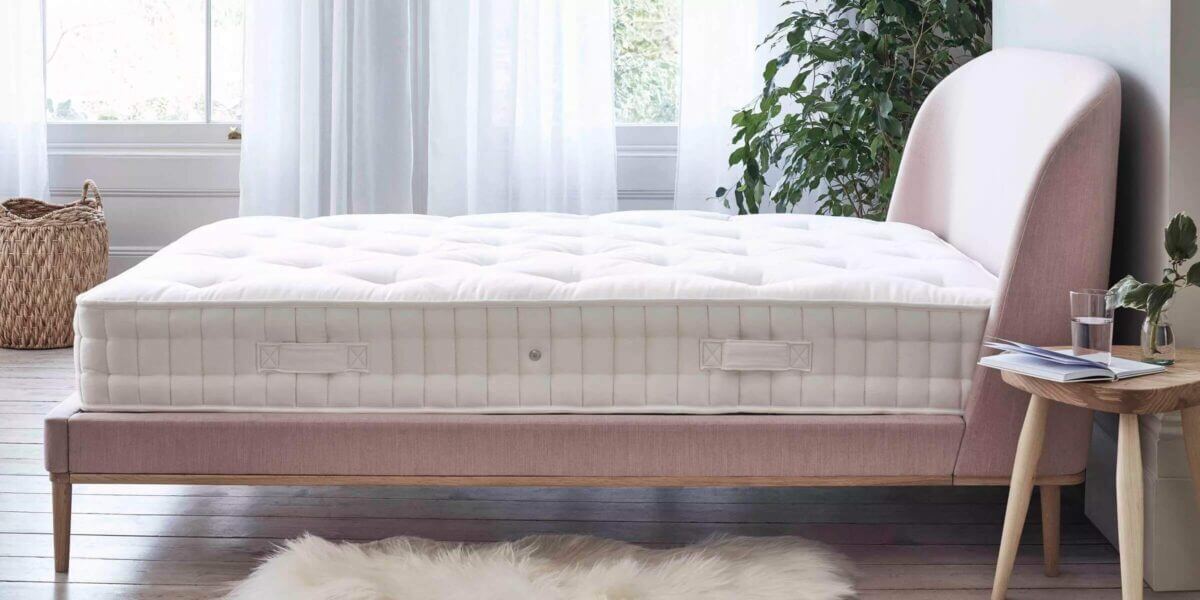
5) Trial period, warranty, and return policy
Even if a thousand people love a mattress, it doesn’t mean you will too. You will respond to your mattress differently depending on your body type. Before you buy a mattress, it’s important to be aware of your trial period, mattress warranty coverage, and return policy. Most of our favorite mattresses come with very generous trial periods, warranty policies, and hassle-free returns.
It is also a good idea to let your mattress “break in” for at least 30 days before getting rid of it. (Though if you want a refund, we don’t recommend actually kicking it to the curb.) For reference, most online mattress companies offer trials of 100 nights or more.
6) Mattress Shipping
Quick definition: Your mattress will be delivered to your home in the following manner.
Our favorite mattresses ship free and fast, but you should also pay attention to the shipping method. If you live in a small apartment or walk-up apartment, it may be more convenient to ship a mattress compressed in a box than a full-size one.
We know it’s hard to imagine something as large as a mattress being shipped in a box that’s only a fraction of it, but it’s certainly possible. Suppliers will use customized cartons made by a carton box machine to pack them. Here is the proof! You probably aren’t going well if you can’t imagine carrying a full-size mattress up a flight of stairs. There are also companies that will charge you for your old mattress and install the new one for you.
8. How to choose a mattress according to your sleeping position
When choosing a new mattress, it’s important to consider your sleeping position so you can find the right bed for your specific needs.
1) Side sleeper
Side sleepers should look for a medium-firm mattress that balances contoured comfort with base support. Memory foam or foam hybrid mattresses are often ideal for side sleepers. These beds do a great job of distributing your weight evenly across the mattress to avoid pressure point pain in your shoulders and hips.
2) stomach pillow
People who sleep on their stomachs need a firm mattress to support the pressure on the lumbar spine due to this sleeping position. It is crucial to keep the hips aligned with the shoulders, so avoid mattresses that are too soft and can cause sagging.
Find a bed with a supportive base and pressure-relieving comfort layers, such as innerspring or hybrid beds, which are best for bed rest.
3) Backrest sleepers
As long as your mattress also supports proper spinal alignment, sleeping on your back is the best sleeping position for you. When you sleep on your back, you need a mattress that provides comfort and support at all the right places and provides rebound when you need it. Supine sleepers will benefit from a medium-firm mattress that supports areas of potential tension and keeps the hips and shoulders in alignment.
4) Combined sleepers
Combination sleepers who move back and forth between positions in the middle of the night need a mattress that’s firm enough so you don’t sink in and get stuck, but not so firm that it’s uncomfortable to spin around. Motion isolation is also important if you sleep with a partner so your movements won’t disturb them.
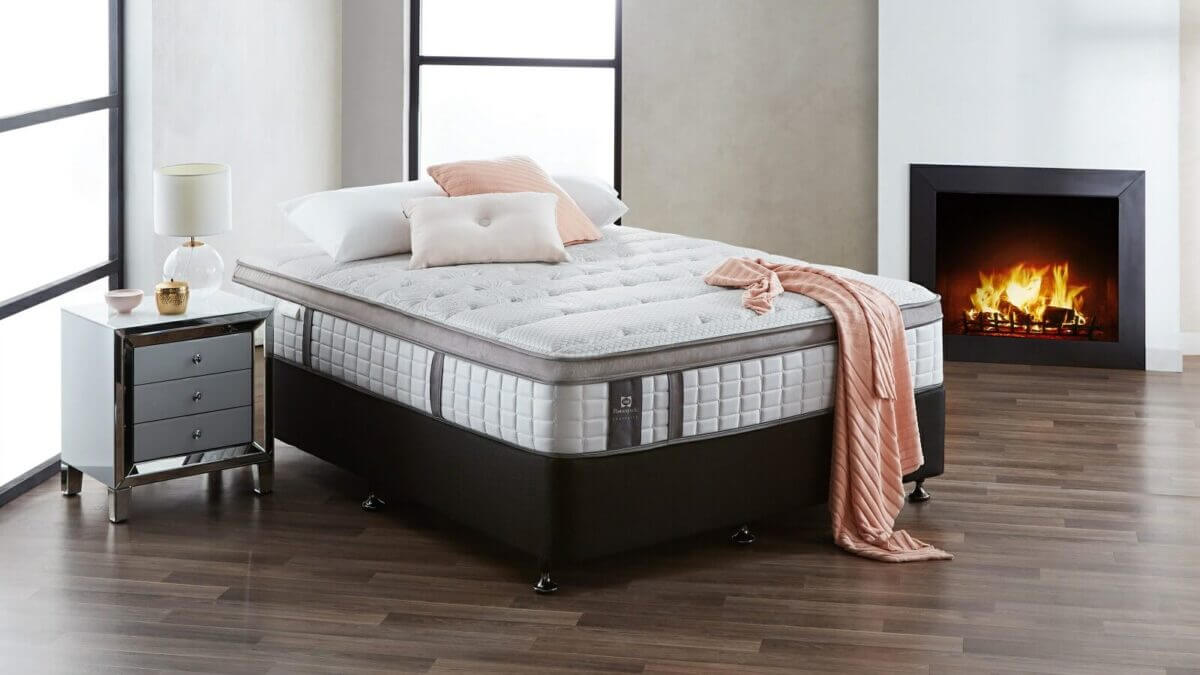
9. Choose a mattress based on your body type
Just like sleeping position, body shape, and weight can affect the choice of the best mattress for spinal support, comfort, and other important attributes. Due to the lighter profile, people under 130 lbs will not sink as deeply into the mattress. If they sleep on their side or have significant pressure points, they may benefit from a softer mattress.
Innerspring mattresses tend to be less fitting, and foam or hybrid beds are attractive options. People, between 130 and 230 pounds can generally follow our mattress firmness recommendations based on the sleeping position in the previous section. Foam, hybrid, and latex mattresses are all solid options and can be selected based on their specific characteristics and design.
Mattresses can sink deeper into people over 230 pounds, especially near heavier parts of the body, resulting in spinal disorders. These sleepers typically do better with firmer mattresses that help avoid this risk.
Responsive mattresses are easier to move on, which is valuable for people over 230 pounds because it reduces the feeling of being stuck in bed. Latex and hybrid options tend to be the most sensitive.
Durability is important for sleepers of any weight, but those over 230 pounds may experience more wear and tear on the mattress’s top layer. For this reason, heavier sleepers often opt for thicker comfort system mattresses that use high-density materials.
Choosing the right mattress isn’t just about weight. People with wider shoulders or hips may need a softer mattress, especially if they sleep on their side. Mattress dimensions should be carefully considered if you are taller than six feet.
10. Choose your mattress based on the price
Mattresses are the most used piece of furniture, so they’re a great investment. At the same time, it can be a significant financial investment, and price is a central factor to consider when buying a mattress. A helpful exercise for most shoppers is to consider their overall bedroom budget. In addition to a new mattress, you may need new pillows or bedding.
Mattress prices range from extremely low-cost, low-quality models all the way up to six-figure designer beds. Those outliers aside, most mattresses cost between $600 and $2,000. Mattresses with more features and a solid design usually cost more, but that doesn’t mean more expensive is better, which is good news for those on a budget. Some factors can affect mattress pricing:
- Materials: Certain types of materials, such as latex, usually cost more. Also, using high-end, handcrafted, organic, or other exotic materials can drive up the price of a mattress.
- Construction Type: How a mattress is constructed can affect its price. In general, taller mattresses with more layers cost more.
- Brands: As with most consumer goods, some brands, especially those that aspire to be luxury brands, charge more.
- Origin: If a mattress and its components are made in the United States, it will likely be more expensive than a mattress made overseas.
- Where it sells: Buying online often means lower prices, but there are also opportunities to find bargains at mattress stores, especially for savvy negotiators.
For anyone concerned about the cost of a new mattress, there are a few things to keep in mind. First, great value can be found throughout the mattress price range.
Second, the prices we’ve listed above are suggested retail prices, or in other words, list prices. Customers rarely pay this price because of the many regular sales, promotions, and discounts. For example, many brands run sales on holidays like Labor Day, Memorial Day, Cyber Monday, and Black Friday. If you shop online, deals are usually available right away.
And third, while it can be a big expense, it’s worth buying a good mattress. An ideal mattress is not only good for your health, but also has better durability, you won’t need to buy another mattress for many years.
11. How to choose a mattress for your child
Children need a good night’s sleep. Children need more hours of sleep than adults, and a good night’s sleep is important at all stages of a child’s development. A quality mattress is a crucial component of ensuring your child gets enough sleep.
There are some overlaps between choosing a mattress for a child and an adult, but there are also some significant differences. A key difference is that safety is a much bigger concern when shopping for a bed for a child, especially a baby who sleeps in a crib. Ensuring that your mattress complies with safety guidelines is critical.
Another difference is the size of the bed. Unlike adults, children may not be able to use a bed when they outgrow it, so it is necessary to consider the most appropriate mattress size based on the child’s age and expected growth.
Depending on the age of the children, they can use a smaller size (twin or king size) bed designed for adults. Other parents may prefer a mattress designed specifically for children. When choosing from the pool of beds available for adults, you have a wider variety of mattress types, models, and brands to choose from.
The cost of children’s mattresses can be another point of disagreement. Many children’s beds are smaller and thinner, and the reduction in the material can make them less expensive. However, there are crib designs with lots of extra features for a similar price to an adult mattress.

12. How to choose a crib mattress
There are a few basic elements to choosing a crib mattress. Safety should be the first consideration when buying any crib mattress. The following are key aspects of crib mattress safety:
- Make sure crib mattresses meet standards set by the Consumer Product Safety Commission (CPSC) for limiting exposure to lead and other compounds.
- Check that the crib mattress meets the CPSC size guidelines for use in a full-size crib. That means at least 27.25″ x 51.25″. It should be no thicker than six inches.
- Choosing a firm crib mattress can reduce the risk of sudden infant death syndrome (SIDS).
- Keep the mattress away from soft objects, including toys, blankets, and pillows. Loose and soft items may pose a risk of suffocation and SIDS and should not be placed in a crib.
Besides safety, crib mattresses must also be reviewed for their convenience and usability:
- EASY TO CLEAN: Messes are almost inevitable on crib mattresses, so an easy-to-keep design is a big plus. For example, some crib mattresses are made with a waterproof cover (often made of vinyl) or waterproof backing. These features simplify cleanup for many parents.
- Weight: You may need to lift the crib mattress to clean it, which is an important factor for some parents in favor of lighter mattresses, such as those made of foam.
- Mattress Type: Available in foam and innerspring options, both can be used to create a firm sleeping surface. Some crib mattresses are also made with eco-friendly materials or components.
- Reversible Firmness: This design allows each side of the crib mattress to feel different. As your child outgrows and doesn’t need to be as firm, the mattress can be flipped over to help extend your purchase.
13. How to choose a mattress cover
If your budget can’t accommodate a new mattress, you might consider a mattress topper as an alternative. This method won’t be as effective or long-lasting, but it can be a useful step if replacing your current mattress isn’t an option.
The topper sits on top of your current bed and under the fitted sheet. It can change the feel of your mattress and is most useful if your main concern is adjusting firmness levels. Some comforters may also add contour, motion isolation, or bounce associated with your old bed.
Most toppers are 1 to 4 inches thick and are made of only one material. Examples of materials used in tops include memory foam, foam, latex, down, cotton, polyester and wool. Each of these materials brings certain benefits and drawbacks.
To choose a mattress topper, consider many of the same elements associated with choosing a new mattress:
- Your sleeping position
- Your body shape
- Your preferred hardness
- Choosing the right type of material
- Your budget
When considering these factors for a mattress cover, be sure to consider your existing mattress as it, along with the cover, will affect the overall feel of the bed. For example, if you have a bouncy innerspring, be aware that it will still transmit motion even with a memory foam top layer.
In the end, if you choose to buy a top hat, it’s important to be realistic. A comforter won’t last as long as a brand-new mattress, nor will it rejuvenate an already worn-out bed. Putting a comforter on a worn and sagging bed will only mean that the comforter will soon start to sag too.
14. Where to buy a mattress
There are many places to buy a mattress when you’re ready to buy one. Mattresses can be purchased online at big box retailers, department stores, furniture stores, mattress specialty stores, and even from the comfort of your own home. We’ll give you the pros and cons of each option so you can decide which one is best for you.
1) Large retailers
Need to shop for groceries and mattresses all at once? This is made possible by big box stores like Costco and Ikea. When you shop at these big box retailers, you’ll often see low prices, but you won’t be able to try out every mattress (often only a few, if any, will be on display). In addition, some of these stores require you to be a member.
2) Department store
Department stores such as Sears and Macy’s offer mattresses in-store. While you can try out mattresses and talk to a salesperson, prices are often high, and salespeople often don’t know mattresses very well if you need help making a selection.
3) Furniture store
Mattresses are furniture, after all. In furniture stores, you can buy multiple pieces of furniture at once, or even bundle them. But the selection of mattresses is usually smaller, and the salespeople often don’t know much about mattresses.

4) Mattress specialty store
If you’re looking for an expert, Mattress Specialty is the place to look. But because you’re dealing with a middleman, you end up paying more for your mattress. If you’re going to one of these stores, get your negotiating skills ready. You might be able to get a price match guarantee.
5) Online
Shopping online is the most convenient way to browse all the options available, but buying a mattress that you can’t see and touch in person first can seem daunting. Some brands have several retail locations, or partner with big box retailers like Target to distribute their products, so sometimes you can actually see the mattress.
The biggest advantage of online shopping is that you can save money and shop conveniently. You can even buy mattresses on Amazon alongside your home shopping.
6) Online and physical stores
One question you might be asking yourself is, “Can I really buy a mattress online without trying it on first?” Fair question. You can’t really tell if a mattress is right for you until you try it out. We’re talking 30 days.
So while you can pick up a mattress at the mattress store and swing on it for a few minutes, you’re not really getting the full experience.
Here are some other reasons why buying a mattress online may benefit you :
- Save money by cutting out the middleman
- Easy to deliver and set up
- The trial period is generous (around 100 days).
- you will save time
- From the comfort of your own home, you can purchase
- Compressed mattresses have better performance (like breaking a pair of jeans)
7) How to negotiate the best mattress price
If you decide to buy a mattress from a store, there are some helpful negotiating techniques you can use to ensure you receive the best price on your new mattress. The good news is that mattress prices are negotiable at most retailers, but the main tactic is trying to pit one seller against another.
For example, if you get an offer from one store, you can take it to its competitors and see if they can beat that price. You can continue this process endlessly by offering lower prices to different competitors and negotiating further reductions. Alternatively, you can find the mattress you want online and have retailers match the prices.
However, if you don’t feel like jumping back and forth between mattress stores, you’ll be happy to hear that online prices are often the best. All you have to do is find the mattress that’s right for you and find comparable models online.
15. When is the best time to buy a mattress?
Mattresses are a big investment, and the best time to buy one is when the price is lowest. Fortunately for many mattress brands and retail stores, these times are fairly predictable and frequent throughout the year.
While not every company participates in these big sales all the time, there’s a good chance you’ll find some great mattress deals during these holiday seasons:
- Black Friday
- Cyber Monday
- Presidents day
- Memorial day
- Independence Day
- Labor day
Keep in mind that most mattress sales start no later than the week before the holiday and may extend into the week after the holiday. You can also expect savings on mattresses during different corporate events, such as grand opening sales, liquidation sales, moving sales, and anniversary sales. None of this is predictable, so pay close attention.
If you’re in the market for a new mattress, you might want to sign up for some of the company’s newsletters to get alerts about sales and discounts. In the future, you can unsubscribe at any time!

16. Mattress FAQs
Here are answers to frequently asked questions about mattresses.
1) How much should I spend on a mattress?
Before you start shopping for a new mattress with our mattress guide, consider how much you’re willing to spend. Mattresses can range from $200 to $10,000, which is a huge price range.
If you’re looking for a higher-quality mattress to sleep on every night, we recommend spending at least $600 on a queen mattress. As prices go up, you’ll often see improvements in product quality, mattress materials used, and even customer service.
2) What if I bought a new mattress and I don’t like it?
Always check sleep trial offers and/or return policies before purchasing a new mattress. Many mattress companies offer “sleep trials,” which allow you to test a mattress on a specific night.
17. Common misconceptions about mattresses
There is a ton of misinformation about mattresses in the world, and we’re here to debunk those myths. Here are some common myths about mattresses and the truth behind them.
1) Myth: You can’t buy a mattress unless you are lying on it first.
The biggest difference people point out about buying a mattress online versus in a store is that you can’t just lay on it and test it out first. In fact, most (if not all) online mattress retailers offer generous risk-free trial periods.
If you decide the mattress isn’t right for you within that time window, you can usually return it for a full refund. Lying on a mattress at the store for 10 minutes doesn’t tell you how well you’re really sleeping on it, as it can take up to 30 days for a mattress to fully crack.
2) Myth: The best mattress should be suitable for all types of sleepers.
Everyone has their own preferences and needs. It’s impossible for a mattress to be a one-size-fits-all bed to appeal to all types of sleepers. The best mattress is the one that best suits your individual needs.
3) Myth: Gel memory foam beds are ideal for hot pillows.
While gel-infused memory foam mattresses are cooler than all-foam beds, they’re still not the best choice for a hot pillow. An innerspring or hybrid bed would be the best choice for a thermal pillow, as the coils leave more room for air to flow.
4) Myth: Quality mattresses are more expensive.
Be careful when you make assumptions that higher cost means higher quality. Retailers often mark up prices to take out the middleman. If you shop online, you can save money, and you don’t have to buy the most expensive bed.
5) Myth: All mattresses need box springs.
There are many different types of mattress foundations to choose from besides box spring mattresses. In fact, some mattresses are even suitable for placing on the floor. The brand you buy from should give you advice on how to find the best foundation to match your bed.
How useful was this post?
Click on a star to rate it!
Average rating 5 / 5. Vote count: 2
No votes so far! Be the first to rate this post.



